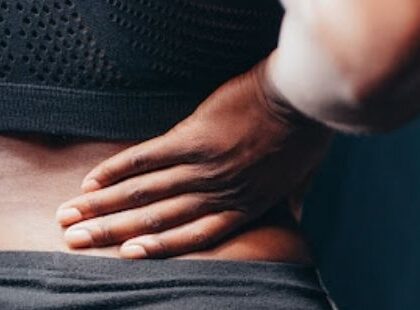3 December 2019

Knee injury is one of the most common and frustrating ailments anyone can experience.
It can become injured in sporting activity as well as in daily life.
Chronic knee conditions can also develop over time, without any kind of deliberate or intense activity.
What exactly is your Knee?

The knee is the central portion of your leg.
It moves like a hinge, opening and closing, which allows you to bend and straighten.
This creates movements like sitting, squatting and allows you to run, walk and jump.
The knee is comprised of five key components:
- Bones. The patella, femur, the tibia and fibula
- Cartilage. The medial and lateral meniscus
- Ligaments. The medial and lateral collateral ligaments (found on the outside of the knee.) The anterior and posterior cruciate ligaments.
- Tendons. These are an extension of the quadricep muscle and attach to the patella.
- Muscles. The quadriceps contracting straightens the knee. The hamstrings contracting bends the knee.
In addition to this there are fat pads, bursa, nerve and blood supply. There is definitely a lot going on.
Knee Injury Categories
Most knee injuries will fall into either an acute or a chronic category.
This means that acute knee injuries have come on suddenly.
Most likely due to a sharp sudden movement or because of an external force or even fall.
Chronic knee injuries happen over time.
They sometimes build gradually or can be as a result of an acute injury that has been left or not properly treated.
Types of Knee Injury
There are so many types of injury to your knee that you can experience.
From fractures and dislocations to patella tracking problems.
We're going to cover some of the most common that we see in our practice.
Patella Femoral Pain Syndrome

This type of injury is in reference to a broad category of pain over the front of the knee.
It's characterised by broad pain and stiffness over the knee cap. Most likely to occur with athletes, but equally can occur with non athletes also.
This pain and stiffness experienced can make it difficult to climb stairs, kneel down and perform every day duties.
Most likely caused from overuse with repeated activity, tension in the muscles and a possible mal-alignment of the knee itself.
Pain is most often experienced as a dull ache over the knee. Pain with bending the knee such as with kneeling or activity or sitting for an extended period of time.
Patella Tendonitis

This is a common injury of the tendon that extends either side of the patella itself. Extending from the quadricep muscle and into the tibia.
Known as an infrapatella tendonitis (below the knee cap) or a suprapatella tendonitis (above the knee cap).
Anyone can develop inflammation here, but it is most commonly seen with athletes.
Factors that can bring on this inflammation are tension in the muscles as well as activity that requires lots of jumping. So basketball, volleyball and sports like tennis where lots of stopping and starting occurs.
You may experience swelling and as the injury progresses a burning pain over the tendon.
Patella Tracking Issues
Simply put, patella tracking injuries are where the patella itself does not track evenly through the groove of the femur.
Most commonly the patella pulls to one side (the outer side) but it can also pull to the inside.
The pull is usually governed by tension within the quadricep muscles. It is also dictated by weakness in muscles and repetitive activities that put stress on the knee.
A key symptom is a feeling that the knee isn't gliding properly as well as a feeling of it slipping or catching when bending.
Cartilage Tears

This injury is in reference to the cartilage that sits within the knee itself known as he meniscus.
The function of this cartilage is to act as an absorbing sponge of the weight of the body and the stresses of running, walking etc.
A meniscus tears most commonly due to twisting injuries, or hyper flexion of the knee.
In some instances conservative treatment of rehabilitation and strengthening can take place. Where more serious tears are present then surgery may be required.
Whilst often asymptomatic once injured, often the injury itself remains front of mind. Swelling and initial discomfort along with instability are the most likely and obvious symptoms.
Ligament Tears

The knee is stabilised by key ligaments that support the medial and lateral parts of the knee.
These are found on the exterior of the knee.
Within the knee joint itself, additional ligaments support the knee from moving too far forward or too far backwards.
These ligaments are taught and designed to keep the knee stable and sturdy. Damage here will create instability.
These ligaments are most likely injured with sudden forces, sudden twists or blunt forces, most commonly at speed.
If the injury to an ACL or PCL is severe enough then further injury to the meniscus can also occur.
Conservative care is definitely indicated here with minor injuries. But with more severe tears then surgery will be required.
What can you do to keep the injury at bay?
There are some really simple things you can do to keep your knee injury at bay.
This includes preventative as well as proactive measures.
- Use a foam roller. Get onto it and roll out your quads, glutes and hamstrings
- Stretch. Be sure to stretch as a cool down at the end of your workout not as a warm up. Leave dynamic stretching and drills as a warm up.
- Use ice. If you're knees are sore after training be sure to whack out the ice pack. This will help settle down any inflammation. Alternate between icing the front and the back of your knee.
- Rest. Know your limits! Sometimes you will need to take a day or two out of your training to help your body heal. You will come back stronger for it.
- Get a Massage. All of the tips above are awesome, and foam rolling is a must, however nothing beats a good pair of hands.
How Can We Help?
Our sports chiropractic services are fantastic at treating knee injury. In fact it's one of our favourites.
As with all injury treatment, it's important to actually treat the injury itself first.
The priority is to relieve the inflammation and decrease the soreness. Once we get you moving again we prescribe you the rehabilitation side of the treatment.
If exercise as a treatment is prescribed too soon, you run the risk of teaching your body new messages with an un solid foundation.
This increases the risk of potential further injury down the track.
The treatment process at Paramount Health includes a comprehensive analysis of your injury.
We conduct orthopaedic testing to ensure we have diagnosed the right injury. We also take the time to understand your history, your goals and your training.
We then treat your injury with various hands on techniques. These include dry needling to remove the swelling and inflammation. We work directly on the tissue to release adhesions and scar tissue. Various other techniques such as mobilising, stretching and strapping are also used to support the recovery.
Every treatment is tailored to you.













